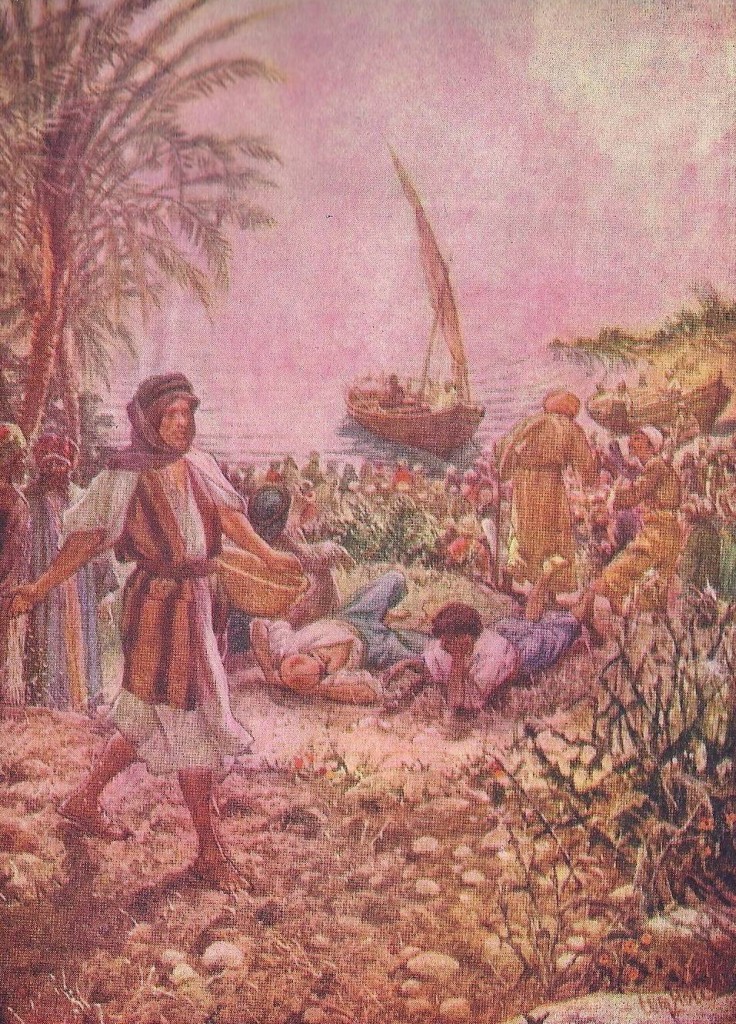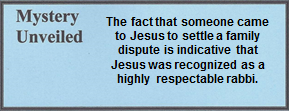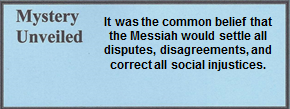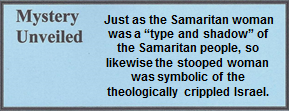09.03.08 Lk. 13:1-5
URGENCY OF REPENTANCE.
1At that time, some people came and reported to Him about the Galileans whose blood Pilate had mixed with their sacrifices. 2 And He responded to them
“Do you think that these Galileans
were more sinful
than all Galileans because they suffered these things?
3 No, I tell you;
but unless you repent,
you will all perish as well!
4 Or those 18 that the tower in Siloam fell on and killed –
do you think they were more sinful than all the
people who live in Jerusalem?
5 No, I tell you;
but unless you repent,
you will all perish as well.”
This discussion was another attempt by the Pharisees to trap Jesus. The conversation is about two separate incidents.
- An incident in which Pilate’s soldiers killed a number of Galilean worshipers in the temple who were offering sacrifices.[1]
- A tower construction accident at the pool of Siloam that resulted in 18 deaths.
The leading Pharisees thought they had created the perfect trap. Since Jesus lived most of His life in the Galilee area, it was expected that He would be sympathetic to those Galileans who were murdered by Pilate. Had He demonstrated such emotions and feelings, the Pharisees would have reported Him as a seditionist against Rome.
On the other hand, there were others who died in a construction accident. It was the common opinion that such accidents were an act of God in response to some horrible sin for which victims were supposedly responsible.[2] Were Jesus to express sympathy for the eighteen who died, He would come against God who cursed them. The idea that an accident or illness could be the natural result of a fallen world had never occurred to them.
If He failed to express emotion and concern for any of them, He would be hardhearted toward the victims and their families. But Jesus was not about to be trapped by their cunning plans or by their misunderstanding of divine judgments. He simply informed them that they too needed to repent or they would perish. The crowds marveled at His response while His critics simply became even more frustrated.
“The Galileans whose blood Pilate had mixed with their sacrifices.” Josephus recorded that the Galileans were especially susceptible to a revolt because they were supportive of the rebellious Zealot movement.[3] The historian essentially said that Herod the Great had built an aqueduct to bring water to the temple area for washing the blood away from the altar and for personal use by the Sadducees,[4] but he died before the project was completed. For more than two decades it was at a standstill until Pilate came to power, he continued the construction. However, since he believed it was for religious use, the temple should pay for it. So Pilate raided the temple treasury to finance the completion of the project.[5] The Jews considered the theft a sacrilege and revolted. Pilate’s militaristic response was reflective of his sadistic character as noted in the historian’s account:
So he (Pilate) called a great number of his soldiers, who carried daggers under their garments. And sent them to a place where they might surround them (the Jews). He asked the Jews himself to go away, but they boldly protested against him. He gave the soldiers that signal which they had beforehand agreed on. They laid upon the Jews much greater blows than Pilate had commanded them, and equally punished those who were tumultuous, and those who were not, nor did they spare them in the least since the people were unarmed . . . There were a great number slain by this means, and others of them ran away wounded; and thus an end was put to this sedition.
Josephus, Antiquities 18.3.2 (61-62)[6]
Numerous scholars have stated that this horrific massacre may have caused the immense hostility between Pilate and Herod Antipas mentioned in Luke 13:1. There was enmity between them until Jesus was brought to trial during the Passion Week.[7]
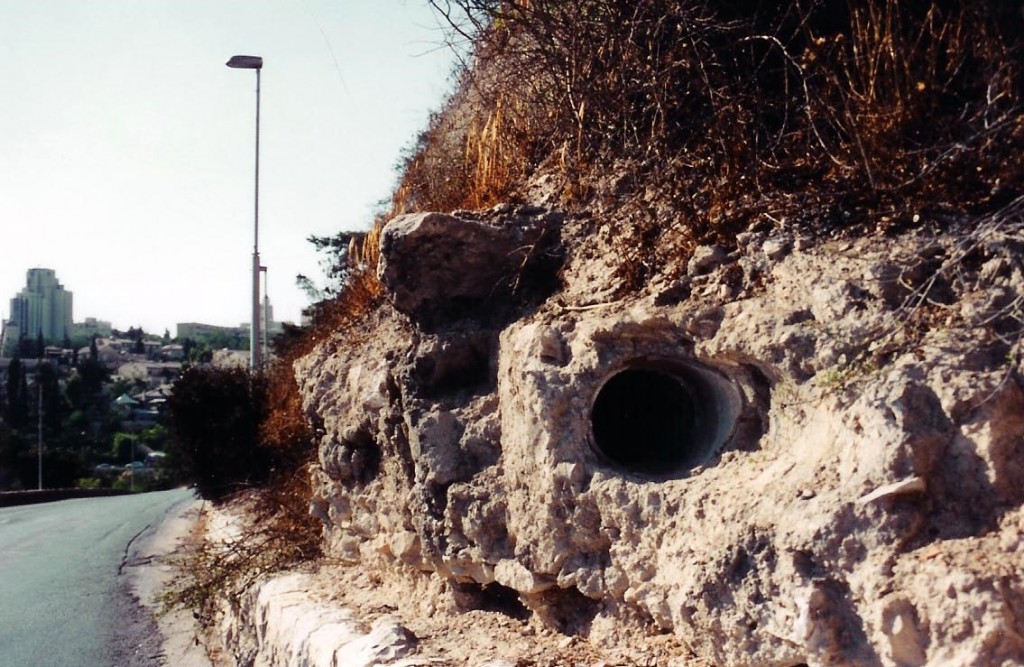
09.03.08.A. HEROD’S AQUEDUCT PIPE. A water line that once served the temple now protrudes from the hillside of a busy Jerusalem street between the Hinnom Valley and the Old City. Herod the Great is credited for bringing to the temple fresh and continuous flowing water from a spring near Bethlehem. This pipe, only 10-12 inches in diameter, snaked along hillsides for ten miles from Bethlehem to the temple and has a vertical drop of only 200 feet – an incredible engineering accomplishment. See also 10.01.20.A. Photographed in 2001 by the author.
The maintenance of the infrastructure of Jerusalem – the walls, water-channels, towers, storm sewers, maintenance workers and street sweepers[8] – were all paid for by the temple.[9] The irony is that when Pilate raided temple funds to complete the construction of the aqueduct, he essentially finished the work that the religious aristocrats were supposed to do in the first place.
“Tower in Siloam.” Scholars have often wondered about the identity of the “tower.” Since there was no military post at the tower, it is believed that it may have been one of the many columns or towers that carried an overhead aqueduct. There are two possible explanations:
- A construction accident. Towers and temporary scaffolding were necessary to construct masonry buildings.
- Destruction as the result of the earthquake of 31 B.C., which killed an estimated 10,000 people.[10] However, the context suggests the accident was a recent event – certainly within the lifetime of Jesus.
Most scholars seem to lean toward a construction accident, as any other event would have had higher casualties that would have been mentioned in this passage.
“Unless you repent.” The word repent in Greek is metanoias, which literally means to change one’s mind. However, in biblical terms as well as first century Jewish culture, to change one’s mind also meant to change one’s lifestyle to match his new way of thinking.[11] This phrase was a warning to national Israel and was mentioned twice in poetic style. This predicted judgment is in reference to the judgment of eternal punishment, but is also of prophetic light to the Jewish-Roman era of A.D. 66-70. Two Hebrew prophets, Hosea (9:10) and Joel (1:7) also gave similar warnings. Joel gave his warning in the 9th century B.C. and about a century later Hosea gave his. Since these two prophets spoke, the people refused to repent and destruction fell upon them in 722/21 B.C. and again in 586/585 B.C.[12] Now it was time for judgement to fall a third time, but it would come in greater measure. Therefore, their proleptic prophecies (prophecies that have been partly fulfilled, but will be completely fulfilled in the future) were fulfilled.
As was previously stated, this was after the turning point of His ministry. He would no longer heal hundreds or give clear teachings; he would heal individuals and teach in parables. The focus was on training His disciples and the coming Gentile church. In this parable Jesus said that life is uncertain, no one knows when they will pass on and therefore, one needs to be ready to meet his Creator at any time.
[1]. Pilate was known for his cruelty and corruption. Later, after he massacred a group of Samaritans, he was recalled to Rome, and is reported to have committed suicide in exile.
[2]. Fruchtenbaum, The Jewish Foundation of the Life of Messiah: Instructor’s Manual. Class 17, page 6.
[3]. Josephus, The Life of Flavius Josephus 92.17.
[4]. See photo of Herod’s Aqueduct pipe at 09.03.08.A. According to author of Pseudo-Aristeas 90, the pipe was sealed with lead and lime mortar.
[5]. See also Josephus, Antiquities 18.4.1-2.
[6]. Parenthesis mine.
[7]. See 15.04.05 for more information.
[8]. Since Jerusalem was considered to be a Holy City, the streets were swept every day (Babylonian Talmud, Baba Metzia 26A and Pesahim 7A). The Valley of Hinnom had a dump site by the dung gate where all the filth was thrown. With the exception of rose gardens, gardens were not permitted in the city because they required dung (Mishnah, Maaseroth 2.5; Babylonian Talmud, Baba Kamma 82B). This illustrates to what measures the laws of purity were taken by the time of Jesus.
[9]. Mishnah, Shekalim 4.2.
[10]. Lightfoot, A Commentary on the New Testament from the Talmud and Hebraica. 3:294.
[11]. Barclay, “Mark.” 26; Richardson, “Repent.” 191-92.
[12]. For more information, read about the Samaritans in 02.01.17, the Assyrians in 03.02.04-05, and the Babylonians in 03.02.08-10.
